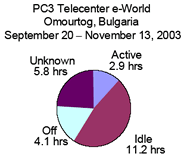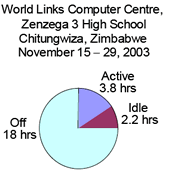Estimating Energy Demand
Home > TOOLS > STEP 2 > Estimating Energy Demand
When estimating the energy demand of an off-grid telecenter, the question of how many hours per day to allocate for PC usage is not a trivial one. If assumptions about expected usage are too high, the energy system will be oversized and will cost more than necessary, reducing the available funding left for other projects. If the usage assumptions are too low, then the energy system may fail to provide enough power. To begin the process of establishing benchmarks for PC usage norms in different types of environments, we asked a small number of grid-connected telecenters and schools around the world to let us monitor their PC usage for at least two weeks. Usage was monitored using Watt Savvy Corporate Edition software provided by Blue Owl Technologies of California, USA . Data on the percentage of time each computer spent in active mode, standby mode, turned off, and other states of power consumption was reported automatically over the internet or sent manually by email. There were three participants from which useful information was gathered during the trial period. One was PC3 e-World, a for-profit telecenter in the remote Bulgarian town of Omourtog. PC3 e-World was established in September 2001 with training and assistance from LearnLink, a USAID-funded project implemented by the Academy for Educational Development (AED). This telecenter has operating hours from 9am to 11pm daily, and is connected to the electricity grid. The second participant was a Telesecundaria high school in Chihuahua, Mexico. Telesecundaria schools in Mexico provide secondary education with support from curriculum-based television programming. The Telesecundaria in Chihuahua operates a computer center for classroom and extra-curricular use during the school week from Monday through Friday, and is connected to the electricity grid. The final participant was a World Links Computer Centre located at Zenzega 3 High School in Chitungwiza, Zimbabwe. The Centre is operated as a community telecenter in which users pay a fee to access the computers. The Centre staff indicated that the facility is open for 10 hours per day, and is connected to the electricity grid. The results of this small sample showed that the commercial PC3 e-World telecenter had the highest usage pattern with the computers in active or idle mode for an average of 14.1 hours per day. PC3’s usage data revealed that several of the computers were kept running 24 hours per day and did not enter standby mode, even when idle for several consecutive hours. The World Links Computer Centre in Chitungwiza, Zimbabwe reported that its PCs were powered on for an average of 6.0 hours per day and shut off for the remaining 18 hours per day during a two-week period in November 2003. Finally, computers at the Telesecundaria in Chihuahua, Mexico were powered on for an average of 3.6 hours per day and shut off for an average of 20.4 hours per day . The monitoring period, extending from October 2003 to March 2004, included weekends and several periods of vacation when the school was closed and the computers were not in use, thus reducing the average daily activity rates. The data showed that the school shut down the computers on most nights and weekends in addition to longer vacations. The range of PC usage rates from 3.6 to 14.1 hours per day points to the tremendous impact that end-user behavior can have on the amount of energy required to power an off-grid telecenter. The institution of simple procedures such as shutting off computers and monitors each night and using standby modes to reduce computer and monitor power consumption while idle can significantly reduce the amount of energy required on a daily basis. Related Web-based Resources
|


